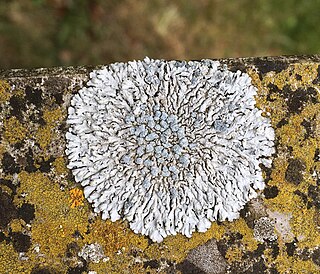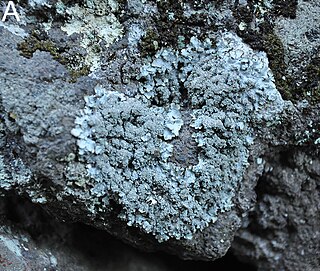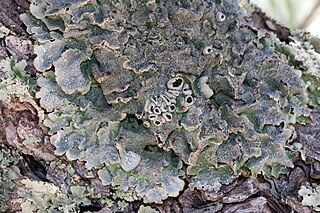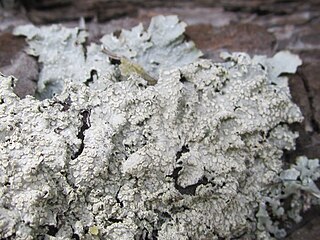
Caloplaca saxicola is a small bright orange crustose lichen that grows on rock all over the world. It is commonly called rock firedot lichen, jewel lichen or rock jewel lichen.

Hypogymnia is a genus of foliose lichens in the family Parmeliaceae. They are commonly known as tube lichens, bone lichens, or pillow lichens. Most species lack rhizines that are otherwise common in members of the Parmeliaceae, and have swollen lobes that are usually hollow. The lichens usually grow on the bark and wood of coniferous trees.

Esslingeriana is a fungal genus in the family Parmeliaceae. The genus is monotypic, containing the single foliose lichen species Esslingeriana idahoensis, commonly known as the tinted rag lichen. It is found in northwestern North America.

Xanthoparmelia mougeotii is a species of foliose lichen belonging to the family Parmeliaceae.

Lecanora muralis(Protoparmeliopsis muralis) is a waxy looking, pale yellowish green crustose lichen that usually grows in rosettes radiating from a center (placodioid) filled with disc-like yellowish-tan fruiting bodies (apothecia). It grows all over the world. It is extremely variable in its characteristics as a single taxon, and may represent a complex of species. The fruiting body parts have rims of tissue similar to that of the main nonfruiting body (thallus), which is called being lecanorine. It is paler and greener than L. mellea, and more yellow than L. sierrae. In California, it may be the most common member of the Lecanora genus found growing on rocks (saxicolous).

Physcia caesia, known colloquially as blue-gray rosette lichen and powder-back lichen, is a species of foliose lichenized fungus. First described by Georg Franz Hoffmann in 1784, it is common across much of Europe, North America and New Zealand, and more patchily distributed in South America, Asia, Australia and Antarctica. There are 2 subspecies: P. c. caesia and P. c. ventosa, as well as a number of distinct forms and varieties. Molecular studies suggest that the species as currently defined may be polyphyletic. It is typically pale gray shading to darker gray in the center, and grows in a small rosette, usually some 2–3 cm (0.79–1.18 in) across at maturity. It only rarely has apothecia, instead reproducing most often vegetatively via soredia, which are piled in round blue-gray mounds across the thallus's upper surface. It grows most often on rock—principally calcareous, but also basaltic and siliceous—and also occurs on bone, bark and soil. It is nitrophilic and is particularly common on substrates where birds perch.

Xanthoparmelia lineola, commonly known as the tight rock-shield, is a foliose lichen species in the genus Xanthoparmelia. It is a common species with a temperate distribution. Found in North America and South Africa, it grows on rocks.

Hypogymnia occidentalis, commonly known as the lattice tube lichen, is a species of foliose lichen in the family Parmeliaceae. It is found in North America, where it grows on the lower trunks of conifers, particularly Douglas-fir.

Hypogymnia imshaugii, commonly known as the forked tube lichen, is a common species of foliose lichen in the family Parmeliaceae. It was formally described as a new species by Norwegian botanist Hildur Krog in 1968. It has a grey to gray-green thallus with slender lobes measuring up to 2 mm wide that are branched dichotomously at regular intervals. It has cup- to disc-shaped apothecia that are constricted at the base. The lichen grows on conifer branches, preferring inland habitats that are moderately dry.

Hypogymnia physodes, commonly known as the monk's-hood lichen, is a species of foliose lichen in the family Parmeliaceae. It is a common and widespread species in boreal and temperate forests of the Northern Hemisphere. It has a grey to yellowish-green thallus that is loosely attached to its substrate and forms large irregular patches. Hollow lobes are 2–3mm wide. The outer edge turns up and is frequently covered with white powdery soredia underneath. Its lower surface is black, wrinkled and has some browning toward the lobe margins. The pycnidia are black and abundant, and their presence creates a pepper-like effect across the upper surface. Because of its abundance and its moderate sensitivity to sulphur dioxide and heavy metals, Hypogymnia physodes is often used in bioindicator and biomonitoring studies that enable the assessment of air pollution and other environmental conditions.

Punctelia guanchica is a species of foliose lichen in the family Parmeliaceae that is only known from the Canary Islands. It is similar in appearance and morphology to the North American Punctelia rudecta, and was historically misidentified as that species until molecular phylogenetic evidence showed it to be a distinct species. It differs in having thicker isidia that develop from the centre of the pseudocyphellae, and it mainly grows on rocks.

Punctelia hypoleucites, commonly known as the southwestern speckled shield lichen, is a species of foliose (leafy) lichen in the family Parmeliaceae. First formally described by Finnish botanist William Nylander as a species of Parmelia, it was transferred to the genus Punctelia in 1982. The lichen is found in Africa, North America, and South America, where it grows on the bark of both hardwood and coniferous trees. Its greenish-grey thallus is covered with tiny white pseudocyphellae – minute holes in the thallus surface that facilitate gas exchange. Some macroscopic features that help distinguish this species from other related members of the genus include the presence and the structure of the apothecia, the absence of asexual surface propagules, and the light brown color of the thallus undersurface. Chemically, the presence of lecanoric acid in the medulla and atranorin in the cortex help distinguish it from lookalikes.

Punctelia bolliana, the eastern speckled shield lichen, is a species of foliose lichen in the family Parmeliaceae. It is found in North America, with a distribution extending from the Canadian province of Ontario south to the central and northeastern United States and Mexico. It grows on the bark of both deciduous trees and coniferous trees. The combination of characteristics that distinguishes this species from others in genus Punctelia are the absence of the vegetative propagules isidia and soralia, a pale brown lower thallus surface, and the presence of the secondary chemical protolichesterinic acid in the medulla.

Punctelia perreticulata is a widely distributed species of foliose lichen in the family Parmeliaceae. It occurs in Mediterranean Europe and Russia, North America, South America, Australia, and New Zealand, where it grows on rocks, bark, or wood. Its main distinguishing features are its thallus surface, marked with many shallow depressions, grooves, or pits, and sorediate pseudocyphellae. The lower side of the thallus is ivory to tan towards the centre and the major secondary metabolite in the medulla is lecanoric acid. A lookalike species with which it has been historically confused is Punctelia subrudecta; this lichen can be distinguished from Punctelia perreticulata by the texture of the thallus surface, or, more reliably, by the length of its conidia.

Punctelia graminicola is a species of foliose (leafy) lichen in the family Parmeliaceae. It grows on rocks, and, less frequently, on bark in North America, South America, and East Africa. It has a blue-grey thallus measuring up to about 15 cm (6 in), covered with tiny pores called pseudocyphellae. Sometimes the lichen forms small lobes that project out from the surface. Fruiting bodies are uncommon in this species; if present, they resemble small cups with a brown internal disc measuring 3–10 mm (0.1–0.4 in) in diameter. A lookalike species, Punctelia hypoleucites, is not readily distinguishable from Punctelia graminicola by appearance or habitat alone; these species can only be reliably differentiated by examining the length of their conidia.
Pseudoparmelia kalbiana is a species of foliose lichen in the family Parmeliaceae. It is found in South America.

Cetrelia chicitae is a species of foliose lichen in the family Parmeliaceae. It is found in eastern Asia, North America, and Europe, where it grows on mossy rocks and tree trunks.

Hypogymnia flavida is a species of foliose lichen in the family Parmeliaceae. It is found in mountainous locations of east Asia, where it grows on the bark and wood of woody plants. It has a relatively large yellowish thallus.
Psiloparmelia salazinica is a species of foliose lichen in the family Parmeliaceae. It is found in South America.

Solorina crocea, commonly known as the orange chocolate chip lichen, is a species of terricolous (ground-dwelling) and foliose (leafy) lichen in the family Peltigeraceae. The lichen, which was first formally described by Carl Linnaeus in 1753, has an arctic–alpine and circumpolar distribution and occurs in Asia, Europe, North America, and New Zealand. It generally grows on the bare ground in sandy soils, often in moist soil near snow patches or seepage areas. Although several forms and varieties of the lichen have been proposed in its history, these are not considered to have any independent taxonomic significance.

















